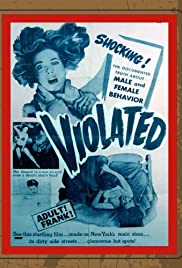
VIOLATED
US, 1953, 78 minutes, Black and white.
William Holland.
Directed by William Strate.
This is a small film of the early 1950s, very small budget, intended for exploitation cinemas of the time. It was probably considered very sleazy at this period but is much more interesting, given changes in the treatment of themes of serial killers, and worth looking at, allowing for its shortcomings.
A number of commentators have compared this with Stanley Kubrick’s Killers Kiss, made at the same period and with touches of similarity. This film was filmed in the streets of New York City and they come rather vividly to life with realistic camera work, the streets, apartments, police precincts, strip club.
The film starts rather graphically with the serial killer committing a murder, the focus on the woman and her becoming a victim. While the audience generally knows who the killer is, there are a number of suspects who are interrogated by the police, eccentric and weak and sinister types, easily suspected. The film is interesting in its presentation of the interrogations.
A chance encounter in the street between a young girl with acting and modelling ambitions, Susan, leads to her talking with the killer, his posing as a fashion photographer, giving her a card, her finding him, talking with her mother and enthusiastic about opportunities, going to his apartment, the suggestiveness of the photos that he wants to take. As expected, later she will become an intended victim.
In the meantime, the killer goes to a strip club, where people have seen him and can identify him, invites home one of the dancers who is provocative towards him, also resistant, and is killed.
The film does not eschew close-ups of the violence and the sexual implications.
Ultimately, the killer is identified, trapped in his apartment, his escaping on the outside of the building but ultimately caught. At this stage, the character of a psychiatrist is introduced with some 1950s explanations of the mental condition of the killer, his serial killing and his motivations.
When the man is brought to trial, there are some pleas about execution, the role of the criminally insane and the kind of justice that they need. However, in keeping with decisions of the time, the judge decides that the killer was sane and orders his execution. The dialogue offers an interesting critique of capital punishment.
The director, William Strate, had made only one film, The Moor’s Pavane (1951). He is not credited with any other film. The serial killer is played by William Holland (Wim Holland) whose only film this is.
A curiosity item but interesting in comparison with small-budget films about serial killers in succeeding decades.